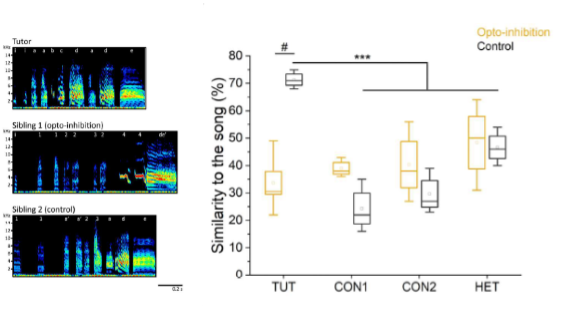FY2020 Annual Report
Neuronal Mechanism for Critical Period Unit
Associate Professor Yoko Yazaki-Sugiyama
Abstract
Songbirds learn to sing their song intensively from their song auditory experience during development as humans learn to speak. Our lab has been investigating the neuronal mechanism underlying how early auditory experiences shape neuronal circuits for song learning and auditory perception and how the time window for this neuronal circuits wiring is regulated by using zebra finch model. Interestingly zebra finch juveniles learn efficiently through social vocal communication with a tutor, while they learn little from passive auditory song experiences. Recent years we have focused more on how social interaction regulate effective song learning. We have investigated how neuronal activities of the attention control nucleus, Locus Cereleous (LC), during social interaction with a tutor and regulate activities of neurons in the NCM which has been suggested to store tutor auditory memories. We found that the LC modulate auditory responses of the NCM neuron to vocal signal from a socially interfacing tutor and song learning from it. We suggest that attention changes by social interaction with tutors leads to altering auditory activities of higher auditory cortex through activities of LC, that would result in intensive memory formation with social vocal communications. Besides this projects our lab has started a new projects where we investigate song memory translocation within zebra finch brain by using newly developed viral vector tools.
1. Staff
- Makoto Araki, Postdoctoral scholar
- Jelena Katic, Postdoctoral scholar
- Sarah Morson, Postdoctoral scholar
- Yuichi Morohashi, Technician
- Anna Kuneji, Technician
- Zhehao Cheng, OIST student
- Yung-Chieh Liu, OIST student
- Chie Edwards, Research Unit Administrator
2. Collaborations
- 2.1 Luke Ramegy-Healry (U Mass) for GABA inhibitory control of auditory activity in zebra finch higher auditory cortical neurons (Supported by NIH RO1 grant)
- 2.2 Jon Sakata and Sarah Woolley (McGill Univ) for innate restriction in bird song learning
- 2.3 Takao Hensch (WPI-IRCN, University of Tokyo) for regulation of the timing critical period by neuronal inhibitory function development (Supported by OIST KICKS grant)
3. Activities and Findings
3.1 Social interaction modulating auditory neuronal activities
Songbirds are learning to sing by hearing of tutor bird singing during development like human babies learn to speak. Juvenile birds intensively learn from the auditory experience through social interactions with tutors, while they learn little from passive auditory experiences, such as playback from a speaker. However, underlaying neuronal mechanism for social interaction dependent song learning has yet to be elucidated. In previous years we showed that a subset of neurons in the higher auditory cortex of juvenile zebra finches exhibit highly selective auditory responses to the tutor song after song learning in the higher auditory cortical area, NCM (Yanagihara and Yazaki-Sugiyama, 2016), and that the selective auditory response are enhanced by the presence of tutor birds (Yanagihara and Yazaki-Sugiyama, 2018). We found that neurons in both in the nucleus Locus Cereleous (LC), the noradrenergic nucleus which control attention, and NCM showed greater auditory responses to live tutor singing than song playback. We further found that the LC neurons project NCM and regulate increased auditory responses to tutor singing. Inactivation of LC inputs to NCM during juvenile birds hearing of tutor singing prevents juveniles from song learning from tutor (Figure 1). Taken together these suggests activity changes in the LC triggered by social interaction with a tutor regulate auditory neuronal activities in the higher auditory cortex neurons of juvenile zebra finches, that may result in forming a memory of tutor songs.

Song similarity scores of the songs of zebra finches, whose activities of LC axon was inactivated during when they heard tutor singing, to tutor songs are significantly lower than those of control birds.
3.2 Identifications of two complemental neuronal circuits for individual varieties and species identities
Continuing from the previous years we anatomically identified the two categories of neurons in the brain area, called Field L, which is homologous to mammalian primary auditory cortex. Previously we found two types of neurons in the Field L which encode complemental temporal and acoustical features of songs, respectively (Araki et al., 2016). By combining the tissue clearing technique, X-Clarity, and virus vector mediated fluorescent protein expressions, we visualized the anatomical structures of hundreds of excitatory neurons in the primary auditory cortex. We then made modeling of soma structures and dendrite arborizations of neurons for categorizing them into group with their anatomical character. We further identified the song responsive neurons anatomically and match them to the categorized group in volume data. Taken together we elucidated the anatomical characterizations of neurons in the zebra finch primary auditory cortex, Field L and identified the neurons which convey temporal and morphological information of songs.You can use "Insert Template" (the Gear icon in the toolbar) to insert figures with captions such as Figures 1 and 2 below. Just try the different layouts. Double-click to replace the image placeholder.

You can also use tables and many other formats. Please see the Manuals website for examples and tutorials.
4. Publications
4.1 Journals
- Kudo T, Morhashi Y and *Yazaki-Sugiyama Y. (2020) Early Auditory Experience Modifies Neuronal Firing Properties in the Zebra Finch Auditory Cortex. Frontiers in Neural Circuits 14:63. doi: 10.3389/fncir.2020.570174
4.2 Books and other one-time publications
Nothing to report
4.3 Oral and Poster Presentations
- Jelena Katic, Yuichi Morohashi & Yoko Yazaki-Sugiyama, Locus coeruleus modulates perception in the auditory cortex during zebra finch song learning, Society for Neuroscience, Global Connectome, Jan 2021
Invited lectures at conferences
- Virtual Songbird Satellite Series, ‘Locus coeruleus regulates cotical auditory memory formation in zebra finch song learning’, Mar 2021
5. Intellectual Property Rights and Other Specific Achievements
Nothing to report
6. Meetings and Events
6.1 OIST Workshop: Online Developmental Neurobiology Course (eDNC)
Co-organized with David Van Vactor, Ichiro Masai, Samuel Reiter.
7. Other
Nothing to report.



